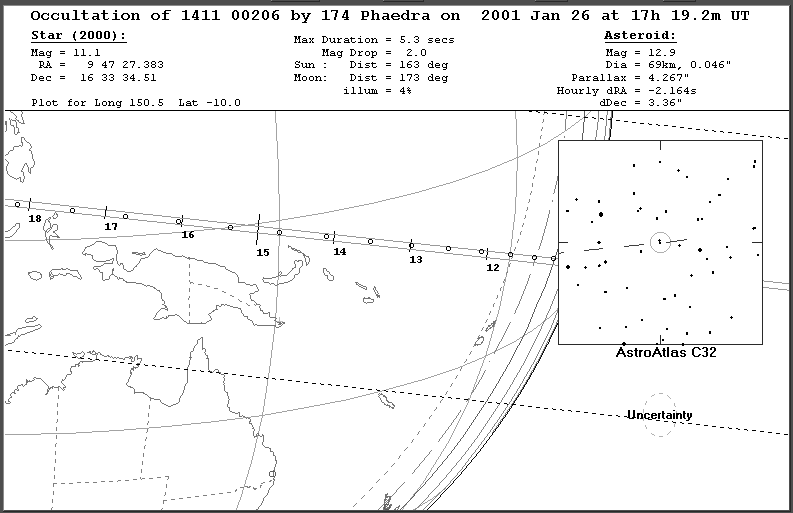ASTROMETRIC UPDATE:
OCCULTATION BY (174) PHAEDRA - 2001 JANUARY 26
CHECK THIS PAGE REGULARLY FOR FURTHER UPDATES AND CHANGES TO THE TRACK.
YOU MUST RELOAD THIS PAGE USING YOUR BROWSER'S
RELOAD/REFRESH BUTTON TO OBTAIN UPDATES!
[Prediction using OCCULT software including finder charts]
The path predicted by OCCULT runs east to west through the central parts of Papua New Guinea. Lae lies on the northern edge of the predicted path.
UPDATE: 20 January 2001
This prediction update has been computed by Stephen Kerr based on astrometry from Ron Stone of the US Naval Observatory - Flagstaff Station. The ACT position of the target star has been used.
Summary:
This event was found by Brian Loader using the OCCULT software and was listed on Page 13 of the RASNZ Occultation Section Circular CN2000/4. Whereas this event was listed using the PPM identifier for the target star, the prediction posted to the website and this update use the ACT references.
Astrometry intended for another event involving (174) Phaedra crossing North America and north-western Africa on Feb 16 (TYC 1403-00772-1) has been used to update this event.
This update suggests that the path has moved around 0.5" to the north and around 30 seconds earlier. This places the path to the north of all of the Papua New Guinea islands. The time for closest approach for Rabaul is 17:14:30 UT and for Madang 17:15:10 UT
Observers should note that only 6 astrometric positions have been used in this update and as such the islands of New Ireland, New Britain and the northern parts of the main island of New Guinea may still lie within the error tolerances of this calculation.
THE EVENT AT ONE GLIMPSE:
- Date and approx. UT time of event: January 26, 2001 @ 17:15 UT
- Magnitude of target star: 11.1 - Note that this is considerably fainter than the 10.2 given in the PPM catalogue.
- Magnitude drop [mag]: 2.0
- Estimated maximum duration [s]: 5.3
- Path description: See above.
The Occultation Path:
- Approximate width [km]: 70
- Map: See below
- Circles along the path are OCCULT calculated exact centerline points !!!!
Data for the target star:
- Name: TYC 1411-00206-1
- Constellation: Leo
- J2000 position [h,m,s; o,',"]: 9h 47m 27.383s; +16o 33' 34.51"
- Position source: ACT
- Estimated accuracy ["]: 0.08" (0.07", 0.05")
- V mag [mag]: 11.1
- B-V [mag]: +0.23
- Remarks:
- The target star is in western Leo. It lies around 7 degrees north-west of Regulus (alpha Leonis mag=1.4) and 2.5 degrees east of 8 Leonis (mag=5.7). A detailed finder chart is attached to the OCCULT prediction and can be reached by clicking here.
Data for the minor planet:
- Number, name: (174) Phaedra
- Approx. diameter [km]: 69
- Source of used astrometry: US Naval Observatory - Flagstaff Station (Ron Stone)
- Number of used observations: 6
- Number of rejected observations: 0
- Time covered by the observations: 2000 11 21 - 2001 01 04
Data for the event:
- UT date and time of least geocentric approach: 2001 January 26, 17:19.2 UT
- Approx. V mag of minor planet at event [mag]: 12.9
- Geocentric parallax of minor planet ["]: 4.267
- Magnitude drop [mag]: 2.0
- Estimated maximum duration [s]: 5.3
- Apparent motion of minor planet ["/h]: 31.38
- Angular distance to moon, phase of moon [deg,%]: 173, 4%
- Update computed by: Stephen Kerr (Win OCCULT 1.4).

IMPORTANT NOTE!
Astrometric updates such as these should not be taken as definitive, but rather only as an indication of where the true track may lie relative to the original predicted track. Observers must bear in mind that later astrometry, in which the target star is measured in the same field as the asteroid, may still reveal substantial changes to the predicted track and time of the event. For this reason it is most important that observers far from the predicted track still monitor the event.
Use these links for further information:
[Planetary Occultations]
[Using the Predictions]
[Observing Details]
[Timing Details]
[Reporting Details]
[Report Form]
[Asteroid Occultation Results]
This page may have been updated since 20 January 2001.
Hit your browser's RELOAD button to get the latest version.
[Site Map]
[What's an Occultation?]
[Total Occultations]
[Grazing Occultations]
[Planetary Occultations]
[Jovian Satellite Eclipses]
[Timing Occultations]
[Reporting Observations]
[Coming Events]
[Software]
[About Us]
[Publications]
[Membership]
[Links]
[Top of Page][Return to Home Page]
